What Can I Expect in a First Reflexology Visit?

The following section walks you through a typical appointment and answers some common concerns.
The intake
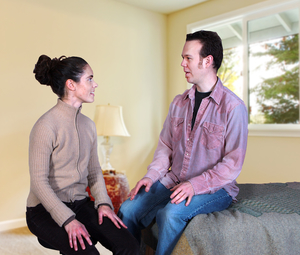 The practitioner will conduct a brief health history, checking in case reflexology may not be the best choice of therapy for you.
The practitioner will conduct a brief health history, checking in case reflexology may not be the best choice of therapy for you.
- The practitioner will explain how reflexology works and what to expect in the session. The reflexologist also informs you that reflexology does not treat specific illnesses and is not a substitute for medical treatment. You may be asked to sign a consent form.
- It is okay, and even expected, for you to ask questions. You should feel comfortable communicating with the reflexologist. If the practitioner is not forthcoming with information, or is dismissive of questions or concerns, this could be a "red flag," and you have every right to terminate the appointment.
Starting the session
The practitioner may choose to work only on the feet, or the hands, or the ears, depending on your specific health issues. Some problems respond better to the reinforcement of work on all three—hands, ears, and feet.
Everyone’s needs are different—for example a patient in the hospital may have IV's and multiple tubes and wires, so a reflexology session may be limited to the feet by necessity.
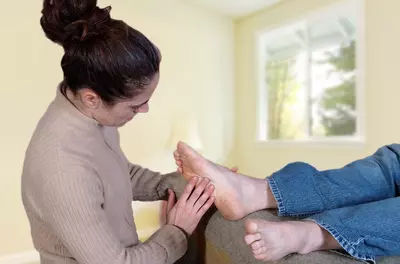
If the reflexologist chooses to work on your feet, you will lie or sit down, remaining fully clothed except for your shoes and socks. The practitioner may wash your feet and soak them in warm water, then position them at his or her chest level.
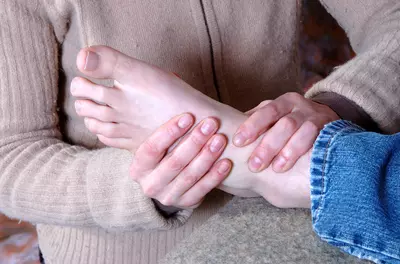
The practitioner will begin by assessing your feet for open wounds, rashes, sores, plantar warts or bunions and will ask you about any foot or leg pain that could hinder treatment.
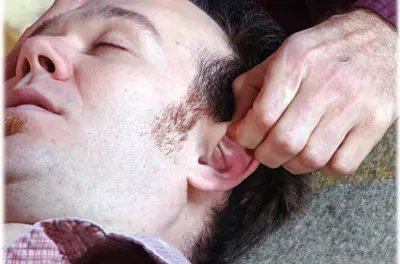
Generally a session lasts between 30-60 minutes. You can rest or talk during the session at your discretion. If you fall asleep during the session, you will still receive the benefits of the treatment.
Feedback during the session is encouraged, and of course, you can request that the session stop at any time.
The focus of the session
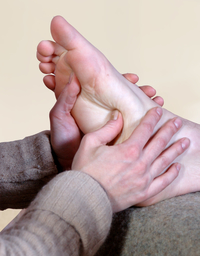 Regardless of your health condition(s) (for example, migraine, nausea, sciatica, etc.), the reflexologist focuses on the entire pattern of the reflexology therapy, starting at the toes and working down the foot. A complete reflexology therapy session uses many different techniques and includes all of the points on both feet (and perhaps the hands and ears).
Regardless of your health condition(s) (for example, migraine, nausea, sciatica, etc.), the reflexologist focuses on the entire pattern of the reflexology therapy, starting at the toes and working down the foot. A complete reflexology therapy session uses many different techniques and includes all of the points on both feet (and perhaps the hands and ears).
By working all of the points, the reflexologist addresses internal organs and glands as well as muscle groups, bones, nerve ganglions (solar plexus, brachial plexus) and nerves (sciatic) during a session.
If you have a specific condition, such as migraines, the reflexologist will carefully feel and work the area corresponding to the presenting problem. However, they will also work all areas of the foot with gentle pressure, because, according to reflexology theories, this allows the nerve pathways and congestion to release and promotes the relaxation response for the entire body.
How pain and discomfort is handled
The first thing to understand is that the reflexologist stimulates the nervous system to do the work of balancing and releasing; it is not the therapist who "fixes" discomfort. In other words, “releasing pain" is not the model; the goal is rather to bring the whole body into balance, and then the pain will subside.
If reflexologists find pain, congestion, or tightness during the session, they will apply pressure to work on bringing the body back into balance.
The reflexologist can return to that area or spot at the end of the session, confirming the pain has released. Throughout the session, the reflexologist will stay present, grounded, and in a calm and centered state of awareness.
What reflexology feels like
Experiences with reflexology sessions vary from a general feeling of relaxation, to a sense of "lightness" or tingling in the body, as well as feelings of warmth, a sense of "opening," or "energy moving" from the practitioner's pressure to the specific body area or organ. There is often a physical perception of energy flowing through every organ, valve, gland, or muscle, as well as a sense of communication between each body system.
Normal reactions
Other reactions during the session range from physical to emotional and may include:
✔ Perspiration of hands or feet ✔ Sensation of being cold or chilled ✔ Feeling light-headed ✔ Coughing ✔ Laughing ✔ Crying ✔ Sighing deeply ✔ Overwhelming desire to sleep ✔ Disappearance of all pain and discomfort ✔ Loose, relaxed muscles and organs ✔ Thirst ✔ Rarely, contraction of muscle groups (pain)It bears repeating: Reflexologists do not diagnose
Reflexologists do not diagnose or tell you about any congestion or tension they observe on the foot, hand, or ear during a session that may suggest abnormalities.
One of the theories of reflexology is that the body will nurture and repair itself once released from stress. If the body is extremely stressed, the reflexologist may refer you to a medical team or another treatment, if appropriate, but at no time will he or she give medical advice or diagnosis.
The end of the session
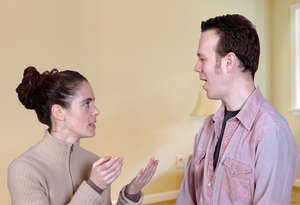 Most reflexologists have some type of calm, peaceful way of closing the session that involves stroking the hand or foot and holding the limb in some manner. The important aspect is for you to feel comforted and nurtured.
Most reflexologists have some type of calm, peaceful way of closing the session that involves stroking the hand or foot and holding the limb in some manner. The important aspect is for you to feel comforted and nurtured.
Now that the session is complete, you should not feel rushed. Gently bring yourself back into the present moment, and orient yourself. As you feel comfortable, gather yourself and your belongings to leave.
The practitioner may recommend that you drink water, rest if necessary, and pay attention to your body in the next few hours. If any questions or concerns arise, you should be able to call the practitioner.
After a reflexology treatment
Various reactions may occur following a reflexology session. These, too, are subtle, and are often not recognized by many people as a result of the reflexology therapy. Many of the reactions are positive signs that the session is part of a healing process; other symptoms are indicative of the body's attempts to return to a state of balance and harmony. Symptoms usually last for 24-48 hours.
Normal reactions
Reactions to reflexology treatment may include:
✔ Increased energy ✔ Enhanced sleep ✔ Relief from pain ✔ More mobile joints ✔ Tiredness ✔ Skin rashes, pimples, or spots (due to elimination of toxins) ✔ Kidney stones passed with ease ✔ Frequent bowel movements, diarrhea (cleansing, elimination of toxins) ✔ Increased mucus (nasal discharge, vaginal discharge) ✔ Emotional or psychological release (crying)Scheduling follow-up sessions
The number of sessions varies and is determined by the client's health and reasons for seeking reflexology. But in general, results from reflexology are often subtle and are cumulative. Thus, you are more likely to see greater benefits from regular sessions (for example, once a week for six weeks) than if you had a session once every six months.
If you are dealing with a specific illness or condition, you may need to have more frequent sessions. A general recommendation might be to begin with a session every week for 6-8 weeks, followed by a "tune-up" every four weeks.
Learn online with Coursera

Introduction to Integrative Therapies and Healing Practices
This course will teach you how to safely use integrative therapies in your life and/or work, and how to assess if integrative therapies are good options in specific situations. You also will get a brief introduction to aromatherapy, botanical/herbal medicine, mindfulness, and guided imagery (which you can explore further in the other courses in the specialization).

Herbal Medicine on Coursera
This course will give you the knowledge of how and when to use botanical medicine. You might be surprised to learn that you may already be using herbal medicines. Taking this course will provide you with the background to safely and effectively incorporate herbal medicines into your personal life and/or work.
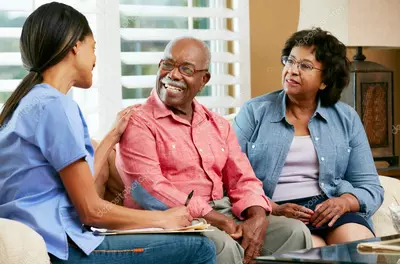
Integrative Nursing Specialization
If you are a health professional interested in learning how to integrate person-centered care and healing modalities into your practice, or if you are personally interested in learning how to use these options for your own or your family's health, check out our specialization. It includes courses on guided imagery, aromatherapy, and applied mindfulness, as well as the practical application of an integrative nursing approach.
Crane, B. (1997). Reflexology: The Definitive Practitioner's Manual. London, Great Britain: Butler & Tanner Ltd.
Dougans, I., & Ellis, S. (1992). The Art of Reflexology: A New Approach Using the Chinese Meridian Theory. Shaftesbury, Dorset: Element.
American Reflexology Certification Board. (1999). Study Guide Outline. Gulfport, FL: American Reflexology Certification Board.

